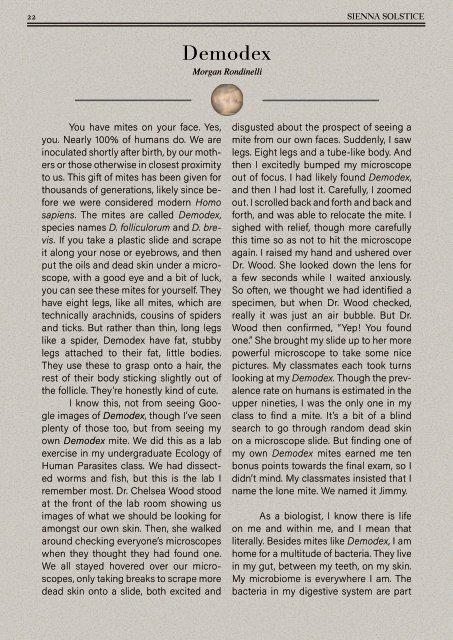Create successful ePaper yourself
Turn your PDF publications into a flip-book with our unique Google optimized e-Paper software.
22 SIENNA SOLSTICE<br />
Demodex<br />
Morgan Rondinelli<br />
You have mites on your face. Yes,<br />
you. Nearly 100% of humans do. We are<br />
inoculated shortly after birth, by our mothers<br />
or those otherwise in closest proximity<br />
to us. This gift of mites has been given for<br />
thousands of generations, likely since before<br />
we were considered modern Homo<br />
sapiens. The mites are called Demodex,<br />
species names D. folliculorum and D. brevis.<br />
If you take a plastic slide and scrape<br />
it along your nose or eyebrows, and then<br />
put the oils and dead skin under a microscope,<br />
with a good eye and a bit of luck,<br />
you can see these mites for yourself. They<br />
have eight legs, like all mites, which are<br />
technically arachnids, cousins of spiders<br />
and ticks. But rather than thin, long legs<br />
like a spider, Demodex have fat, stubby<br />
legs attached to their fat, little bodies.<br />
They use these to grasp onto a hair, the<br />
rest of their body sticking slightly out of<br />
the follicle. They’re honestly kind of cute.<br />
I know this, not from seeing Google<br />
images of Demodex, though I’ve seen<br />
plenty of those too, but from seeing my<br />
own Demodex mite. We did this as a lab<br />
exercise in my undergraduate Ecology of<br />
Human Parasites class. We had dissected<br />
worms and fish, but this is the lab I<br />
remember most. Dr. Chelsea Wood stood<br />
at the front of the lab room showing us<br />
images of what we should be looking for<br />
amongst our own skin. Then, she walked<br />
around checking everyone’s microscopes<br />
when they thought they had found one.<br />
We all stayed hovered over our microscopes,<br />
only taking breaks to scrape more<br />
dead skin onto a slide, both excited and<br />
disgusted about the prospect of seeing a<br />
mite from our own faces. Suddenly, I saw<br />
legs. Eight legs and a tube-like body. And<br />
then I excitedly bumped my microscope<br />
out of focus. I had likely found Demodex,<br />
and then I had lost it. Carefully, I zoomed<br />
out. I scrolled back and forth and back and<br />
forth, and was able to relocate the mite. I<br />
sighed with relief, though more carefully<br />
this time so as not to hit the microscope<br />
again. I raised my hand and ushered over<br />
Dr. Wood. She looked down the lens for<br />
a few seconds while I waited anxiously.<br />
So often, we thought we had identified a<br />
specimen, but when Dr. Wood checked,<br />
really it was just an air bubble. But Dr.<br />
Wood then confirmed, “Yep! You found<br />
one.” She brought my slide up to her more<br />
powerful microscope to take some nice<br />
pictures. My classmates each took turns<br />
looking at my Demodex. Though the prevalence<br />
rate on humans is estimated in the<br />
upper nineties, I was the only one in my<br />
class to find a mite. It’s a bit of a blind<br />
search to go through random dead skin<br />
on a microscope slide. But finding one of<br />
my own Demodex mites earned me ten<br />
bonus points towards the final exam, so I<br />
didn’t mind. My classmates insisted that I<br />
name the lone mite. We named it Jimmy.<br />
As a biologist, I know there is life<br />
on me and within me, and I mean that<br />
literally. Besides mites like Demodex, I am<br />
home for a multitude of bacteria. They live<br />
in my gut, between my teeth, on my skin.<br />
My microbiome is everywhere I am. The<br />
bacteria in my digestive system are part






